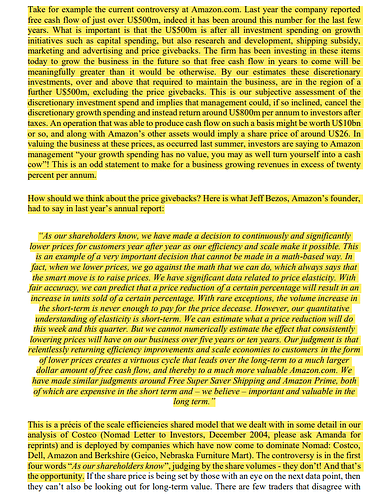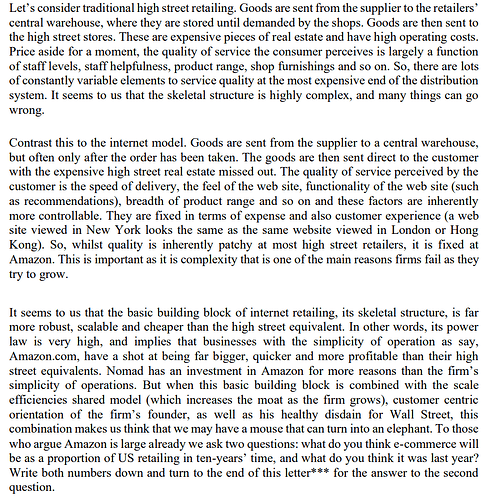A letter a day!
Letter 74 #2020
Key learnings:
- Berkshire’s investment in Apple vividly illustrates the power of repurchases.
It started purchasing apple late in 2016 and by july 2018 owned slightly more than a billon shares. It finished its purchases by mid 2018,Berkshire’s general account owned 5.2% of Apple.
“Our cost for that stake was $36 billion. Since then, we have both enjoyed regular dividends, averaging about $775 million annually, and have also – in 2020 – pocketed an additional $11 billion by selling a small portion of our position. Despite that sale – voila! – Berkshire now owns 5.4% of Apple. That increase was costless to us, coming about because Apple has continuously repurchased its shares, thereby substantially shrinking the number it now has outstanding. But that’s far from all of the good news. Because we also repurchased Berkshire shares during the 21⁄2 years, you now indirectly own a full 10% more of Apple’s assets and future earnings than you did in July 2018.”
- Story of Buffett’s early years : How he started!
"Before my Berkshire years, I managed money for many individuals through a series of partnerships, the first three of those formed in 1956. As time passed, the use of multiple entities became unwieldy and, in 1962, we amalgamated 12 partnerships into a single unit, Buffett Partnership Ltd. (“BPL”).
By that year, virtually all of my own money, and that of my wife as well, had become invested alongside the funds of my many limited partners. I received no salary or fees. Instead, as the general partner, I was compensated by my limited partners only after they secured returns above an annual threshold of 6%. If returns failed to meet that level, the shortfall was to be carried forward against my share of future profits. (Fortunately, that never happened: Partnership returns always exceeded the 6% “bogey.”) As the years went by, a large part of the resources of my parents, siblings, aunts, uncles, cousins and in-laws became invested in the partnership.
Charlie formed his partnership in 1962 and operated much as I did. Neither of us had any institutional investors, and very few of our partners were financially sophisticated. The people who joined our ventures simply trusted us to treat their money as we treated our own. These individuals – either intuitively or by relying on the advice of friends – correctly concluded that Charlie and I had an extreme aversion to permanent loss of capital and that we would not have accepted their money unless we expected to do reasonably well with it.
I stumbled into business management after BPL acquired control of Berkshire in 1965. Later still, in 1969, we decided to dissolve BPL. After yearend, the partnership distributed, pro-rata, all of its cash along with three stocks,
the largest by value being BPL’s 70.5% interest in Berkshire. Charlie, meanwhile, wound up his operation in 1977. Among the assets he distributed to partners was a major interest in Blue Chip Stamps, a company his partnership, Berkshire and I jointly controlled. Blue Chip was also among the three stocks my partnership had distributed upon its dissolution. In 1983, Berkshire and Blue Chip merged, thereby expanding Berkshire’s base of registered shareholders. from 1,900 to 2,900. Charlie and I wanted everyone – old, new and prospective shareholders – to be on the same page. Therefore, the 1983 annual report – up front – laid out Berkshire’s “major business principles.” The first principle began: “Although our form is corporate, our attitude is partnership.” That defined our relationship in 1983; it defines it today. Charlie and I – and our directors as well – believe this dictum will serve Berkshire well for many decades to come."
- In 1958, Phil Fisher wrote a superb book on investing. In it, he analogized running a public company to managing a restaurant. If you are seeking diners, he said, you can attract a clientele and prosper featuring either hamburgers served with a Coke or a French cuisine accompanied by exotic wines. But you must not, Fisher warned, capriciously switch from one to the other: Your message to potential customers must be consistent with what they will find upon entering your premises.
“At Berkshire, we have been serving hamburgers and Coke for 56 years. We cherish the clientele this fare has attracted.”


